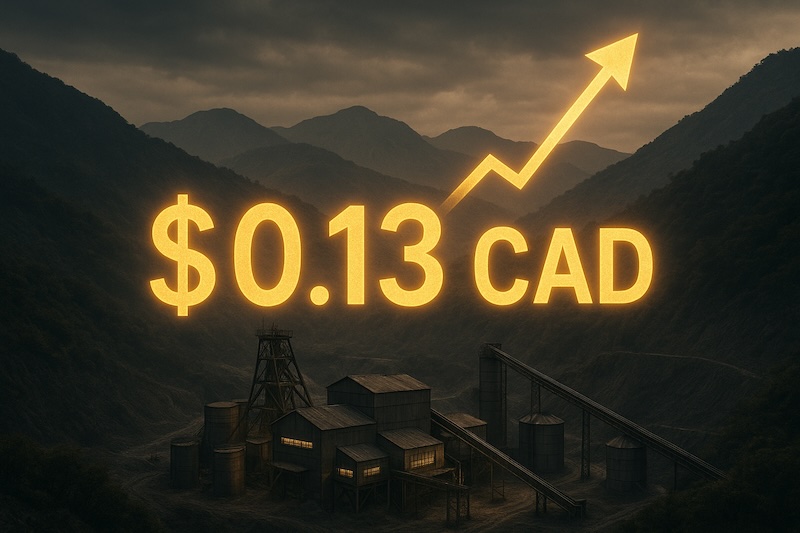Mining Stocks: A Complete Investment Guide
Gold and silver mining stocks represent ownership in companies that extract precious metals from the earth. Unlike physical bullion, mining stocks offer potential leverage to metal prices, often delivering amplified returns when gold and silver prices rise. This investment avenue provides exposure to precious metals without the need to store physical assets.
At GoldSilver.ai, we provide comprehensive tools and resources to help investors navigate the complex world of mining stocks. Whether you're looking to build a diversified portfolio of mining companies, analyze individual stocks, or track global mining projects, our platform offers everything you need to make informed investment decisions in the precious metals sector.
From junior explorers with high growth potential to established producers with steady dividends, the mining stock universe offers opportunities for various investment strategies. Our tools help you identify the right mix of companies based on your risk tolerance and investment goals.
Powerful Tools for Mining Stock Investors
Our suite of specialized tools helps you research, analyze, and track gold and silver mining investments. From portfolio management to company analysis, we provide everything you need to succeed in precious metals investing.
Analyze performance, track gains, and optimize your mining stock investments with our advanced portfolio tools.
Access detailed profiles, financial data, and performance metrics for hundreds of gold and silver mining companies.
Explore mining projects worldwide with details on reserves, production, and development status.
What are gold and silver mining stocks?
Gold and silver mining stocks represent ownership stakes in companies that explore for, develop, and produce precious metals. These companies range from early-stage explorers searching for new deposits to established producers with multiple operating mines around the world.
Unlike physical gold and silver, mining stocks are financial assets traded on stock exchanges. Their value is influenced by both the price of the underlying metals and company-specific factors such as production costs, reserve quality, management expertise, and operational efficiency.
Mining stocks offer a different risk-reward profile compared to physical metals. While they can provide leverage to rising metal prices (potentially outperforming the metals themselves), they also carry company-specific risks that don't affect physical bullion.
Why invest in mining stocks?
Investing in gold and silver mining stocks offers several potential advantages over other investment options, including physical precious metals. Here are some key reasons investors choose mining stocks:
- Leverage to metal prices: Mining companies can deliver amplified returns when metal prices rise. A 10% increase in gold prices might translate to a 20-30% increase in profits for a gold producer with fixed costs.
- Income potential: Some established mining companies pay dividends, providing income that physical metals cannot offer.
- Growth opportunities: Mining companies can grow through exploration success, acquisitions, or operational improvements, potentially delivering returns even in flat metal markets.
- Portfolio diversification: Precious metals mining stocks often have low correlations with broader equity markets, especially during periods of economic uncertainty.
- Convenience: Investing in mining stocks eliminates the storage, insurance, and security concerns associated with physical metal ownership.
Our portfolio tools help you build a diversified mining stock portfolio aligned with your investment goals and risk tolerance.
How to Invest in Gold and Silver Mining Stocks
Follow this step-by-step guide to build a successful precious metals mining stock portfolio that aligns with your investment goals.

Before investing, familiarize yourself with the different types of mining companies: major producers, mid-tier producers, junior miners, explorers, and royalty companies. Each category offers different risk-reward profiles.
Use our company database to research different mining companies.

Evaluate mining companies based on their reserves, production costs, management quality, balance sheet strength, and growth prospects. Look for companies with quality assets in stable jurisdictions.
Our comparison tool allows you to filter out companies based on your criteria.

Examine the quality of a company's mining projects, including resource size, ore grade, infrastructure access, and political risk. The value of a mining company is ultimately determined by its assets.
Use our mining projects database to research individual mines and development projects around the world.

Create a balanced portfolio that includes different types of mining companies. Consider allocating a larger portion to established producers for stability, while adding select junior miners for growth potential.
Our portfolio builder helps you construct and track a diversified mining stock portfolio tailored to your risk tolerance.

Regularly review your mining stock investments, tracking both company-specific developments and broader trends in precious metals markets. Be prepared to adjust your portfolio as conditions change.
Our portfolio tracking tools provide real-time updates on your investments and alert you to significant developments that may impact your holdings.

Keep up with industry news, metal price trends, and macroeconomic factors that influence the mining sector. Understanding the broader context helps you make better investment decisions.
Use our metal price charts and read our blog articles to stay informed about the precious metals market.
Types of mining companies
The gold and silver mining sector encompasses various types of companies, each with distinct risk-reward profiles. Understanding these categories helps investors build balanced portfolios tailored to their investment objectives.

- Major Producers
Large-cap mining companies with multiple producing mines, substantial reserves, and global operations. These companies typically offer more stability, lower volatility, and often pay dividends. Examples include Newmont Corporation, Barrick Gold, and Agnico Eagle.
- Mid-Tier Producers
Mid-sized companies with established production but smaller than majors. They often offer a balance of stability and growth potential, sometimes with higher leverage to metal prices than major producers.
- Junior Producers
Smaller companies with production but limited operational history or single-mine operations. These stocks typically offer higher leverage to metal prices but come with increased operational and financial risks.
- Developers
Companies transitioning from exploration to production, with defined resources and ongoing project development. These stocks offer significant upside potential if development is successful but face financing and execution risks.
- Explorers
Early-stage companies focused on discovering new deposits. These high-risk, high-reward investments can deliver exceptional returns on discovery but face substantial dilution and failure risks.
- Royalty and Streaming Companies
Companies that provide upfront capital to miners in exchange for the right to purchase metals at predetermined prices or receive a percentage of revenue. These businesses offer exposure to precious metals with reduced operational risks and better margins.
Each type has its own unique characteristics and investment strategies. Understanding these distinctions is key to building a well-rounded mining stock portfolio.
Risks and considerations
While mining stocks offer significant potential rewards, they also come with unique risks that investors should understand before allocating capital to this sector.
- Operational risks: Mining operations face challenges including equipment failures, labor disputes, accidents, and natural disasters that can disrupt production and impact profitability.
- Geopolitical risks: Mines operate in diverse jurisdictions worldwide, exposing companies to political instability, regulatory changes, taxation issues, and in extreme cases, nationalization or expropriation.
- Resource depletion: Mines are depleting assets with finite lifespans. Companies must continuously explore and develop new projects to replace depleted reserves.
- Commodity price volatility: Fluctuations in gold and silver prices directly impact mining company revenues and profitability, creating earnings volatility.
- Environmental and social risks: Mining activities can have significant environmental impacts and affect local communities, potentially leading to regulatory challenges, reputational damage, or project delays.
- Financing risks: Smaller mining companies often require external capital for exploration and development, which can lead to dilution or high debt levels.
GoldSilverAI Core Portfolio
A curated selection of my favourite gold and silver mining companies.
Total Performance this year
413.84%
Number of Positions
24
Top Positions
These are the largest holdings by value.
The pros and cons of buying individual gold and silver mining stocks
| Pros | Cons |
|---|---|
| Unlimited growth potential as mining companies discover new resources | Risky because of market volatility and unpredictable commodity prices |
| Acts as a hedge against inflation and economic downturn | Can be affected by political and social unrest in the geographic locations of mines |
| Good addition to a diversified portfolio | Requires intricate research to understand mining processes and company operations |
| Ability to capitalize on rising gold/silver prices | Performance can be affected by environmental concerns and regulations |
Mining Stock Insights
.jpg)
Spanish Mountain Gold (SPA) owns 100% of its BC project. Strong PEA, 4.7M oz resource, insider backing, yet trading at just ~3% of spot NPV.

Discover why Silver Storm Mining (TSX.V: SVRS) could be the cleanest silver restart play in the market. With a proven 34M oz producing asset, $150M+ in infrastructure, and backing from First Majestic and Eric Sprott, this 0.13 CAD stock offers huge upside as production restarts in 2025.

AGX.V stock analysis: Silver X Mining turns profitable in Q1 2025 with 102M oz resources and production scaling to 4.2M oz annually. Undervalued at $52M market cap?

Hercules Metals (BIG.V / BADEF) kicks off a focused 12,000m drill program at its Leviathan porphyry project in Idaho. Backed by Barrick, with copper-silver upside and low geopolitical risk, this could be one of the top junior mining plays of 2025.
Common pitfalls to avoid when investing in gold and silver mining stocks
As you venture into the world of gold and silver mining stocks, it's crucial to be aware of some common pitfalls that investors often encounter. Let's look at these challenges and how to avoid them:
1. Overlooking Research
Some beginners make the mistake of skipping thorough research and due diligence before investing in mining stocks. This could lead to ill-informed decisions, and potentially significant financial loss.
Tip to avoid: Make it a rule to research every opportunity meticulously. Understand the company, its track record, and the potential risks involved before making any investment commitments. You can use our stock list and company pages as a starting point.
2. Chasing High Returns
It's natural to be attracted by the lure of high returns. However, harbouring unrealistic expectations and chasing non-viable opportunities can be harmful.
Tip to avoid: Approach investing with realistic expectations, keeping in mind that while mining stocks can be lucrative, they are also risky. Take a measured approach and factor in possible losses.
3. Neglecting Diversification
Putting all your eggs in one basket, i.e., investing in a single mining stock can be dangerous. If that stock takes a hit, your investment can significantly deplete.
Tip to avoid: Spread your investment across multiple stocks to reduce the risk of a big loss from just one. Our portfolio tool lets you set the maximum percent a single stock can have and gives warnings if you go over.
4. Ignoring Market Trends
Being insensitive to market trends and failing to adapt can make you miss significant opportunities or expose you to avoidable risks.
Tip to avoid: Keep an eye on market trends and tweak your investment strategy when needed. Be prepared to change course but avoid reacting too quickly to market ups and downs. You can track metal prices and trends here.
5. Underestimating the Importance of Management
The performance of a mining company depends largely on the competence of its management team. Overlooking the role of company leadership is a common mistake.
Tip to avoid: Take into account the company's leadership and their track record in the industry when gauging its potential prospects.




